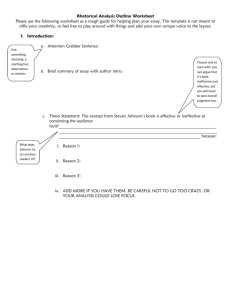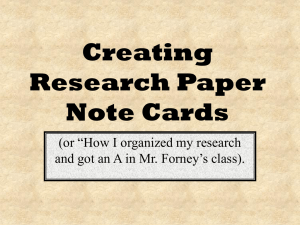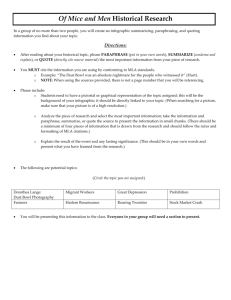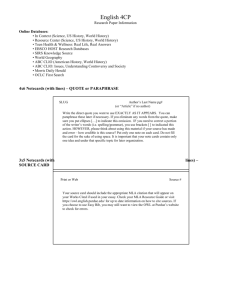Research Schedule: HONORS
advertisement
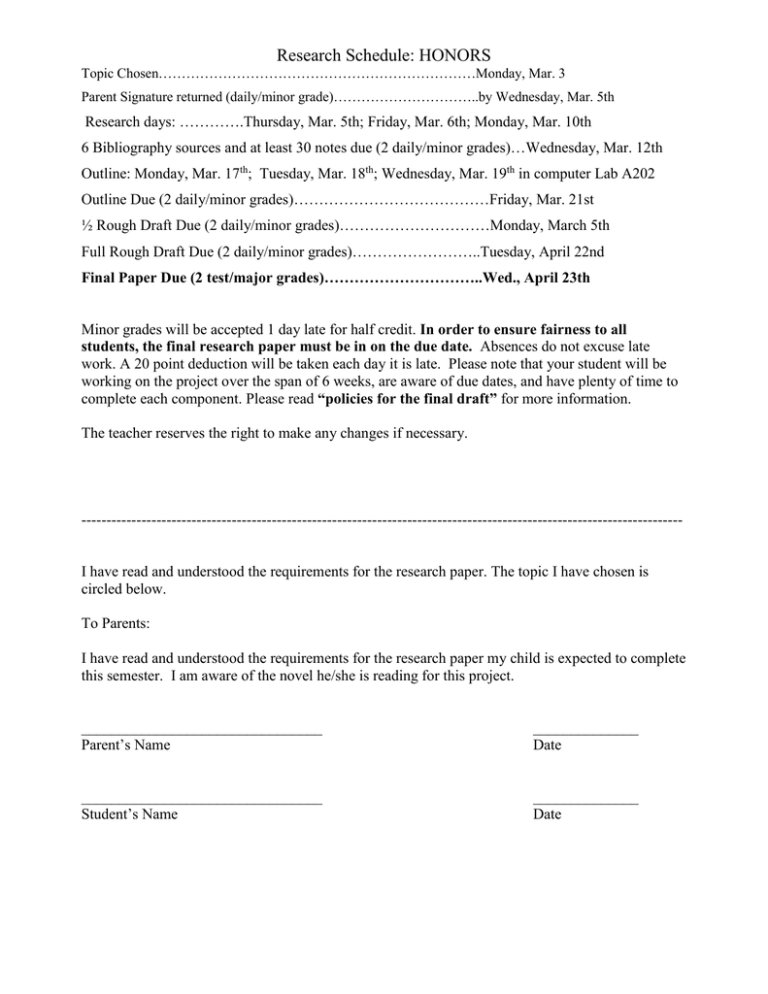
Research Schedule: HONORS Topic Chosen……………………………………………………………Monday, Mar. 3 Parent Signature returned (daily/minor grade)…………………………..by Wednesday, Mar. 5th Research days: ………….Thursday, Mar. 5th; Friday, Mar. 6th; Monday, Mar. 10th 6 Bibliography sources and at least 30 notes due (2 daily/minor grades)…Wednesday, Mar. 12th Outline: Monday, Mar. 17th; Tuesday, Mar. 18th; Wednesday, Mar. 19th in computer Lab A202 Outline Due (2 daily/minor grades)…………………………………Friday, Mar. 21st ½ Rough Draft Due (2 daily/minor grades)…………………………Monday, March 5th Full Rough Draft Due (2 daily/minor grades)……………………..Tuesday, April 22nd Final Paper Due (2 test/major grades)…………………………..Wed., April 23th Minor grades will be accepted 1 day late for half credit. In order to ensure fairness to all students, the final research paper must be in on the due date. Absences do not excuse late work. A 20 point deduction will be taken each day it is late. Please note that your student will be working on the project over the span of 6 weeks, are aware of due dates, and have plenty of time to complete each component. Please read “policies for the final draft” for more information. The teacher reserves the right to make any changes if necessary. ------------------------------------------------------------------------------------------------------------------------ I have read and understood the requirements for the research paper. The topic I have chosen is circled below. To Parents: I have read and understood the requirements for the research paper my child is expected to complete this semester. I am aware of the novel he/she is reading for this project. ________________________________ Parent’s Name ______________ Date ________________________________ Student’s Name ______________ Date Junior Research Essay Topics “An Episode of War” by Stephen Crane Soldiers during the Civil War were subjected to harsh conditions and inadequate medical care. Research the conditions that soldiers fought under. What did they eat? How did they live? If wounded, what were their survival chances? What type of medical treatment was available? Relate your findings to the story by Stephen Crane. Is Crane’s story an accurate portrayal of the Civil War? “Go Down, Moses” Spirituals Read the section in the Bible’s Book of Exodus that describes the events referred to in “Go Down Moses.” Research the enslaved Israelites and the enslaved African Americans. What parallels can be drawn between their situations? How did their situations differ? “The Gettysburg Address” by Abraham Lincoln and “A Confederate Account of the Battle of Gettysburg” by Randolph McKim “The Gettysburg Address” is the speech Lincoln gave at the dedication of the battlefield at Gettysburg as a national cemetery. The battle that took place on that field some four months earlier was one of the most brutal and significant clashes of the Civil War. Research the battle, why it took place, the casualties sustained on both sides, and the role it played in the war. Relate your findings to the address that Lincoln makes and to the account by McKim. From Hiroshima by John Hersey When the atomic bomb was dropped on Hiroshima and Nagasaki, no one knew about fallout, radiation sickness, or long term contamination of the land. Research the effects that the atomic bomb had on the people of Hiroshima and Nagasaki. Relate your findings to Hersey’s story. Does Hersey give an accurate portrayal of the events that took place? From The Woman Warrior by Maxine Hong Kingston In the selection, Brave Orchid gives her personal impression of Ellis Island. Ellis Island was the chief immigration station in the US from 1892-1943. Research Ellis Island during the time of the story. From where did most immigrants come? What was involved in the immigration process? What were conditions like? Are Brave Orchid’s impressions an accurate portrayal of Ellis Island? From Walden by Henry David Thoreau Within this text, Henry David Thoreau began the tale of his experiment of simple living at Walden Pond. Thoreau outlined his philosophy of life, politics, and nature, laying the foundation for a secure place in the canon of great American writers. How does Thoreau express the concerns of many of his contemporaries as industrialization and war permanently altered the world around them? How does Walden represent the ideals of Transcendentalism? “Mother Tongue” by Amy Tan Amy Tan's short story, “Mother Tongue” is an admirable tale that discusses the implied meaning of languages and how language is not only a device of communication, but a social tool of measuring an individual’s worth. Relate this short story to how language separates, unites, or isolates those who don’t speak the common way as well as others. How does the story reflect the struggle for identity, recognition, and acceptance? “Ambush” From The Things They Carried by Tim O’Brien This excerpt is a memory told to his daughter of the Viet Cong soldier he killed in the Vietnam War. How does this haunting portrait express of the fear and ambivalence experienced by many soldiers as they balance to struggle and survive with their personal values and respect for human life? How does his perspective/point of view show the reader different angles of war and how he feels about it? Is O’Brien’s portrayal of how soldiers reacted to the Vietnam War accurate? “Fall of the House of Usher” by Edgar Allan Poe An unnamed protagonist is summoned to the remote mansion of his boyhood friend, Roderick Usher. Consider the role of the narrator. Does he become a character in his own right, and does the horror of the tale depend in part on our ability to see events through his experience? How does Poe lend the narrator the qualities of a character like the others? “The Life You Save May Be Your Own” by Flannery O’Connor A shiftless man takes advantage of an old woman’s trust, putting her handicapped daughter in danger. Why and how does Flannery O’Connor address issues such as religious faith and hypocrisy? How does the work represent the decay of morality? How is this work representative of Southern literature? “Everyday Use” by Alice Walker Dee, the narrator’s daughter, comes home to take the butter churn and a quilt—both artifacts that reveal her family history. How are Dee and Maggie foil characters? How does Walker use irony to express the chasm between modern African Americans and their heritage/past? “Douglass” and “We Wear the Mask” by Paul Lawrence Dunbar Dunbar is a well-known Harlem Renaissance poet. How do his poems represent the themes of the Harlem Renaissance? How does he create a collective identity for the African American people? How do the poems reflect the struggle for identity, recognition, acceptance, and equality? “Birches” and “Acquainted with the Night” by Robert Frost Dealing with emotional issues can be both complicated and perplexing. Frost is courageous enough to look back on sadder times as well as to recollect a fond memory—he is honest enough to know that life includes both the swing of birches and the darker moments of the soul. How does Frost use literary and structural elements to portray both the lighter and darker sides of life? “Song of Myself” by Walt Whitman This is an optimistic poem that relates the individual experience to all mankind. How does Walt Whitman depict significant scenes for any human being such as love, friendship, nature, horrors of war, life, death, and religion? How is this poem representative of Transcendentalism? “Because I Could Not Stop for Death” and “I Heard a Fly Buzz—when I Died” by Emily Dickinson Emily Dickinson was a well-known recluse whose works weren’t published until after her death. Some critics state that while her work is popular, it is limited in theme. Do you agree or disagree? Discuss the themes present in her poetry (loneliness, mortality, etc.). How does her use of literary devices enhance the themes present? “The Jilting of Granny Weatherall” by Katherine Ann Porter On her death bed, an old woman contemplates her life and family. How does this work represent the themes of modernism? How does the stream of consciousness structure work within the text? In other words, how is this work an example of modern literature both thematically and structurally? Required Components: 1. Thirty full notes, each matched to one of six required bibliography entries. 1 source will be your story/stories (primary), 2 sources must be from books or anthologies, 3 sources may be from approved online websites and databases. This means that you will have a total of 30 pieces of information coming from at least 6 different sources. All notecards and bibliographic information will be entered into a Word Document and will be printed out for a grade. Example of Bibliography Entry: Thoreau, Henry David. “Civil Disobedience.” Timeless Voices, Timeless Themes: The American Experience. Ed. Kate Kinsella, et. al. Upper Saddle River: Prentice Hall, 2004: 412-413. Print. Example of Note Entry: Slug (Topic/what the note is about)- Individuality Quote or paraphrase WITH citation “The character of the American people has done all that has been accomplished; and it would have done somewhat more if the government hadn’t sometimes got in its way” (Thoreau 413). 2. Thesis. These should be one sentence, as specific as possible, and should be the first card turned in with the note cards with the students name on it, and it should precede the topic outline. Lesson on thesis statements will be on Wednesday, March 12th. 3. Outline. The outline must have at least three main points (labeled I, II, III) and two categories minimum under each point (labeled with letters starting with “A”). If you include sub categories (labeled starting with 1) you must have at least two. Transitions should be included between each major Roman numeral. Remember: this example is the required minimum; if you have more roman numerals, categories or support, please include them. Citations must be included with quotes and/or paraphrases. Lesson on lead-ins, internal citations, paraphrasing, and transitions will be on Thursday Feb. 16th. Students will have class time to create their outlines: March 17th-19th. Thesis Statement: I. Topic Sentence A. Point 1 1. supporting quote or paraphrase 2. supporting quote or paraphrase B. Point 2 1. supporting quote or paraphrase 2. supporting quote or paraphrase Transition: II. Topic Sentence A. Point 1 1. supporting quote or paraphrase 2. supporting quote or paraphrase B. Point 2 1. supporting quote or paraphrase 2. supporting quote or paraphrase Transition: III. Topic sentence A. Point 1 1. supporting quote or paraphrase 2. supporting quote or paraphrase B. Point 2 1. supporting quote or paraphrase 2. supporting quote or paraphrase Transition to conclusion: 4. ½ Rough Draft. A minimum of 2.5 typed pages, double-spaced pages. The rough draft must include: A) an introductory paragraph with thesis highlighted; B) paragraph(s) that develop the first full point of the thesis, a highlighted transition, and the beginning of the next point; C) examples of paraphrasing, direct quotation, and citations equaling 1/2 of the requirements for the final paper (see below). Lesson on Intros and Conclusions will be on Friday, March 20th. 5. Full Rough Draft. Must have all requirements listed below. Students should be prepared to edit this draft in class on Tuesday, April 22nd . 6. Final Paper. Specific requirements below under “Technical Requirements” and “Content Requirements.” Final paper is due Wednesday, April 23rd Technical Requirements A. 5-6 double spaced, typed pages (12 pt font, TNR. 5th page must be at least ¾ full to count as a page). B. A minimum of 20 citations using MLA parenthetical citation. Example: Percy believes that Gibbon’s experiences in childhood are directly related through the characters in Ellen Foster (Percy 55). C. 6 of the citations must be direct quotes, 1 of which should be in excess of fifty words and which should be in long quote/block format. 3 direct quotes should be from the primary source (novel). Example: Ellen states, “when I was little, I used to think of ways to kill my daddy” (Gibbons 1). D. Correct MLA format, including heading, title, citation form, page numbers and works cited page (does not count toward page total). E. Correspondence between citations in the essay and sources listed in the works cited. Content Requirements A. An effective introductory paragraph, which includes a thesis. B. Full, logical development of the thesis throughout the essay. C. A conclusion which draws its assumptions from the main points covered in the paper D. Smooth use of transition words and sentences to connect ideas and paragraphs. E. An analytical approach, which is student-generated and focused, with sources used primarily for support of the student’s argument. F. Intelligent, interesting discussion, analysis, comparison, contrast, statement and argument of ideas. G. A clear distinction between the writer’s thoughts and your own ideas H. Writing which has style, clarity, precision, and flair I. Use of example from literary work to illustrate and support J. Correct spelling, grammar, and usage K. Use of active voice Policies for the final draft: 1. Turn in the essay without a cover. MLA does not use a cover sheet. 2. The paper is due at the beginning of the period on the due date. If you either check-in or out so that you are not in class on the due date, you must personally bring the paper by my room or have someone deliver it to my box. 3. If you are absent on the due date, excused or unexcused, you must make arrangements to bring the paper to me by 3 PM of the due date. Email is an option as well. 4. Papers are deducted 20 points for each day they are late. 5. Please check your printer’s functioning before the last minute. Printer problems are not an excuse; only typed, complete assignments will be accepted. No disks! Papers must be printed BEFORE entering the classroom! 6. Plagiarism, deliberate or inadvertent, will result in a zero for the assignment.
